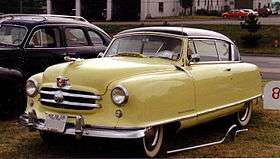Beep, beep (sound)
"Beep Beep" is onomatopoeia representing a noise, generally of a pair of identical tones following one after the other, often generated by a machine or device such as a car horn. It is commonly associated with the Road Runner cartoon (meep, meep) in the Looney Tunes cartoons featuring the speedy-yet-flightless bird and his constant pursuer, Wile E. Coyote. Beep, Beep is the name of a 1952 Warner Brothers cartoon in the Merrie Melodies series.
Road Runner cartoons
Chuck Jones, the creator of the Road Runner, has stated that this sound, the only way the Road Runner can harm the Coyote, was inspired by hearing a Doppler-like effect as background artist Paul Julian imitated a car horn when he could not see where he was going. Julian voiced the various recordings of the phrase used throughout the Road Runner cartoons, although on-screen he was uncredited for his work. Although commonly quoted as "meep meep", Warner Brothers, the current owner of all trademarks relating to the duo, lists "beep, beep" as the Road Runner's sound, along with "meep, meep." According to animation historian Michael Barrier, Julian's preferred spelling of the sound effect was "hmeep hmeep".[1]
In 1978, Warner Brothers recycled the Road Runner's "beep, beep" sound for its television series, Wonder Woman, which featured a tiny robot-on-wheels named Rover who makes the "beep, beep" sound on occasion. It only appeared in the second season episode "I.R.A.C. is Missing".

So popular was the image of road-burning speed inspired by the Road Runner, that Plymouth (a division of Chrysler) named one of their V8-powered "Muscle Car" models after the cartoon bird. The car was fitted with Road Runner decals and a horn that made the well-known "beep, beep" sound when activated.
The Road Runner cartoon also later became associated with Time Warner's Road Runner cable internet service.
In comic books, the Road Runner's actual name was given as "Beep Beep". In the Simpsons episode "Itchy & Scratchy & Poochie", Homer Simpson meets a character – not Julian – who says she recorded the sound of the Road Runner. She comments, "They paid me for one beep, then they doubled it up on the soundtrack."
The Playmates

"Beep, Beep" ("The Little Nash Rambler") was a song which utilized the "beep, beep" sound in a tempo-changing novelty record recorded by The Playmates in 1958. The record became a #4 hit on the Billboard Top 40 chart for twelve weeks. The lyrics tell the story of how the beep-beep horn of the "Little Nash Rambler" following close behind the driver of a Cadillac infuriates him into going ever faster—but the Rambler driver keeps pace with the Cadillac, in order to yell out of his window to the Cadillac driver in the final line of the song, "Hey, buddy, how can I get this car out of second gear?" [2]
References
- ↑ Barrier, Michael. "Fast and Furry-ous" on Looney Tunes All-Stars: Part 1 (Region 2 DVD release). (DVD commentary). Event occurs at 6m10s.
Even though the expression was spelled 'beep beep' on the screen, and that the word 'beep' was used in many subsequent Road Runner cartoon titles, Paul Julian insisted that the correct spelling was 'H-M-E-E-P"; 'hmeep hmeep', rather than 'beep beep'. But obviously after dozens of Road Runner cartoons, and other appearances of the Road Runner and Coyote in other media, with the word 'beep' attached, it's much too late to make any change in that spelling.
- ↑ Time Magazine "Rambler in High Gear" December 8, 1958. Retrieved on June 20, 2007.
External links
- Plymouth Road Runner
- 1969 Roadrunner Forum
- http://www.allpar.com/model/roadrunner.html
- http://looneytunes.warnerbros.com/web/stars/stars_wile.jsp